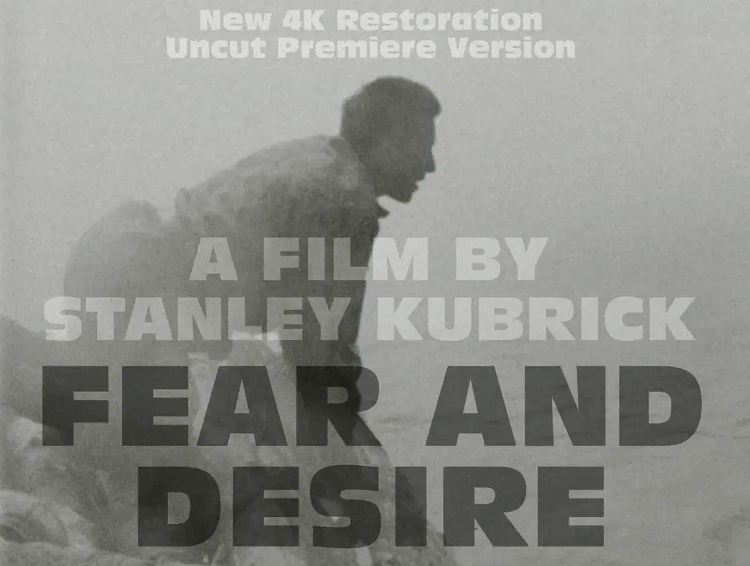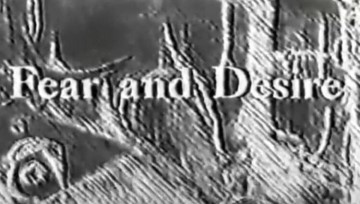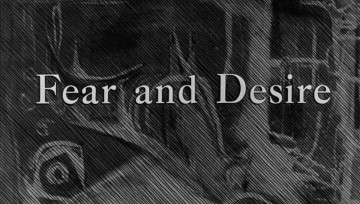
Stanley Kubrick’s debut feature film, Fear and Desire, will be released by Kino Lorber on UHD and blu-ray next week in its original version, which is nine minutes longer than the theatrical cut. Kino Lorber previously issued the theatrical version of Fear and Desire—and one of Kubrick’s short films, The Seafarers—on blu-ray and DVD in 2012. The same transfer was issued on blu-ray and DVD by Eureka! in 2013. (The Eureka! discs included not only Fear and Desire and The Seafarers, but also Kubrick’s other shorts, Day of the Fight and Flying Padre.)
Fear and Desire was originally titled Shape of Fear, and had a running time of seventy minutes. In his book Stanley Kubrick Produces, James Fenwick reported that Shape of Fear was shown at the Venice Film Festival in 1952. Film historian Gian Piero Brunetta subsequently discovered correspondence between Kubrick and the festival’s director confirming that the film was shown out-of-competition at Venice.
For its US theatrical release, Kubrick cut nine minutes of footage to increase the film’s pace, and it was retitled Fear and Desire to target the sexploitation market. (Arguably the same mistake was made in 1999, when Eyes Wide Shut was marketed as an erotic thriller.) Kubrick made Fear and Desire independently, and controlled the rights to its distribution after its initial theatrical run. Apparently embarrassed by the film, he sought to prevent it from being shown again, though there were occasional unauthorised screenings in the 1990s.
Fear and Desire was originally titled Shape of Fear, and had a running time of seventy minutes. In his book Stanley Kubrick Produces, James Fenwick reported that Shape of Fear was shown at the Venice Film Festival in 1952. Film historian Gian Piero Brunetta subsequently discovered correspondence between Kubrick and the festival’s director confirming that the film was shown out-of-competition at Venice.
For its US theatrical release, Kubrick cut nine minutes of footage to increase the film’s pace, and it was retitled Fear and Desire to target the sexploitation market. (Arguably the same mistake was made in 1999, when Eyes Wide Shut was marketed as an erotic thriller.) Kubrick made Fear and Desire independently, and controlled the rights to its distribution after its initial theatrical run. Apparently embarrassed by the film, he sought to prevent it from being shown again, though there were occasional unauthorised screenings in the 1990s.


Kubrick’s decision to cut Fear and Desire was not unusual for the director. He also removed two minutes of footage from Paths of Glory before its theatrical release, and may have deleted a scene from Killer’s Kiss at actress Irene Kane’s request. He cut nineteen minutes from 2001 after its premiere, and removed the climactic custard pie fight from Dr. Strangelove. (The custard pie footage is held in the archive of the British Film Institute, though the Kubrick estate does not allow access to it.) Thirteen minutes were deleted from Spartacus after its premiere. Most famously, Kubrick deleted an epilogue from The Shining and released the film outside the US in a version twenty-five minutes shorter than the American cut.
Until the 2012 blu-ray and DVD releases, the only version of Fear and Desire available on video was a bootleg VHS sold via eBay. This transfer had been duplicated so many times that the image was barely watchable. The difference between the VHS edition and the new Kino Lorber 4k restoration is like night and day, and the company’s forthcoming UHD and blu-ray set will also include 4k restorations of all three of Kubrick’s short films, making it the definitive presentation of the director’s early work.
Until the 2012 blu-ray and DVD releases, the only version of Fear and Desire available on video was a bootleg VHS sold via eBay. This transfer had been duplicated so many times that the image was barely watchable. The difference between the VHS edition and the new Kino Lorber 4k restoration is like night and day, and the company’s forthcoming UHD and blu-ray set will also include 4k restorations of all three of Kubrick’s short films, making it the definitive presentation of the director’s early work.
